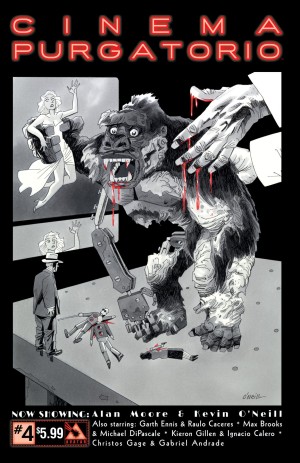
Annotations for “A King At Twilight” 8 pages in Cinema Purgatorio #4
Writer: Alan Moore, Artist: Kevin O’Neill
>Go to overall Cinema Purgatorio annotations index
>Go to Moore-O’Neill Cinema Purgatorio stories annotations index
Note: Some of this is obvious, but you never know who’s reading and what their exposure is. If there’s anything we missed or got wrong, let us know in comments.
General: This issue tells the biography of pioneer stop-animation genius Willis O’Brien voiced by his most famous creation King Kong. In an unpublished interview Alan Moore stated:
…for issue four, Kevin sent me some reference material – a big book on the history of model animation – that contained the heartbreaking biographical details of Willis O’Brien. It was at this point, with the idea to put O’Brien’s story and voice into the mouth of his greatest creation, that we finally realised what we were doing.
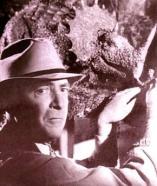
Cover
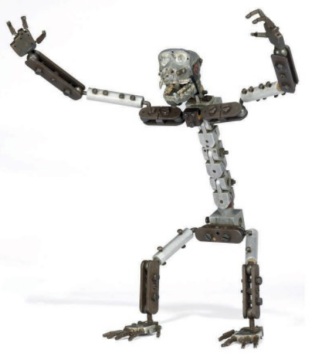
- The cover references the stop-action giant gorilla from the 1933 film King Kong.
- The armature, especially the uncovered arm on the left, resembles the actual original King Kong armature.
- The man standing on the left is Willis H. O’Brien, stop-motion pioneer, creator of King Kong and numerous other early stop motion films. O’Brien was photographed several times wearing a similar hat, see here and here. It is not clear why he stands on the edge of the table – suggest?? (Theoretically the hands in the upper right should be O’Brien’s too.)
- The woman in the white dress is actress Fay Wray playing Ann Darrow. Her pose in the gorilla’s hand resembles this King Kong sequence, which combines a stop motion gorilla body with a live action Wray filmed in giant hand.
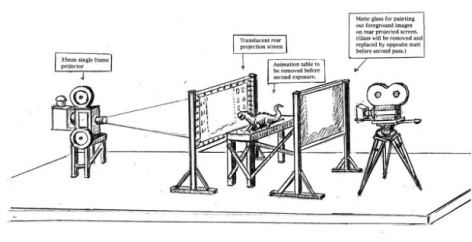
- The projection of Wray’s image on the screen behind the gorilla miniature shows the rear projection technique perfected by O’Brien. This was the way that early films blended stop motion with live action.
- The three dead figurines represent O’Brien’s wife, Hazel O’Brien, and their sons, William and Willis, Jr. William was blind from tuberculosis. In 1933, Hazel shot and killed William and Willis Jr. before turning the gun on herself.
Page 1
panel 1
- A “Humber Hawk” is a type of British car. This is the latest suggestion that our protagonist is in some sort of liminal space, not ordinary linear time.
panel 2
- “Eye, the Jury” is a play on the 1953 film “I, the Jury.”
panel 5
- “WKO Wireless Pictures” is a play on “RKO Radio Pictures.” RKO Pictures produced and distributed the 1933 film King Kong.
Page 2
panel 1
- The first-person narration tells the story of Willis H. O’Brien, the stop-motion animation pioneer who animated King Kong.
- O’Brien is in some ways analogous to Alan Moore. Both were (Moore still is) creative mavericks who did work for exploitative creative industries.
- The incongruous dialogue (O’Brien’s words in Kong’s mouth) is somewhat similar to a technique Moore used in Providence #8 where he placed Randall Carver and Robert Black’s dialogue in H.P. Lovecraft characters mouths.
panels 4-5
- These panels form a fixed-camera sequence. This literally references the fixed camera used for early stop-motion animation. The ape’s entire body remains still while the head moves.
Page 3
panel 1
- “Scale of destruction, it was immense. This huge force of nature” has a double meaning: both the S.F. earthquake and the scale of O’Brien’s stop motion monsters, including Kong.
panel 2
- “Steinberg” is not mentioned in O’Brien’s Wikipedia bio. Suggest??
panel 5
- In 1914 Willis O’Brien created the short film The Dinosaur and the Missing Link: A Prehistoric Tragedy.
- O’Brien subsequently did films for Edison.
Page 4
panel 1
- In 1918 O’Brien and Herbert Dawley made The Ghost of Slumber Mountain. According to Wikipedia:
These [earlier Edison] films led to a commission from Herbert M. Dawley to write, direct, co-star and produce the effects for another dinosaur film, The Ghost of Slumber Mountain (1918), for a budget of $3,000. The collaboration was not a happy one and Dawley would cut the 45-minute film down to 11 minutes and claim credit for O’Brien’s pioneering effects work, which combined realistic stop-motion animated prehistoric models with live action. The film grossed over $100,000 and Dawley used the cut effects footage in a sequel Along the Moonbeam Trail (1920) and the documentary Evolution (1923), but O’Brien received little financial reimbursement from this success.
- The details of O’Brien’s feud with Dawley have recently been somewhat disputed by recent research at Cinefex (also summarized at The Optical podcast.) On the other hand, readers are hearing only O’Brien’s side in this story.
- “Animals” has a double meaning here: mean-spirited studio people and monsters like Kong. The sentence “I love my craft…” sounds like it could come directly from an Alan Moore account of his work for DC Comics.
panel 2
- O’Brien was hired by producer Watterson Rothaker.
- “[Arthur] Conan Doyle” was a fiction writer, famous for creating Sherlock Holmes.
- “The Lost World” was a 1913 novel by Arthur Conan Doyle. It was adapted by O’Brien into a film in 1925.
- Nitpick: “favourite” is the British spelling, should probably be “favorite.”
panel 3
- Harry Hoyt directed the 1925 film The Lost World.
- “Bladders that breathed” were among O’Brien’s stop-motion innovations.
panel 4
- All this is O’Brien’s bio.
panel 5
- According to Wikipedia, “O’Brien was married to Hazel Ruth Collette in 1925” but rarebit.org claims they were married in 1917, which seems much closer to the claim that they had been married seven years in 1925.
Page 5
panels 1 and 2
- These panels form a zoom sequence. This is a film technique that Moore uses frequently in comics, including on P1 of Watchmen #1.
- “Hoyt projects… Atlantis, Creation” refer to films O’Brien worked on, but which were canceled before being released.
panels 2-4
- These panels form a fixed-camera sequence.
- The sequence echoes the King Kong scene where the gorilla strips Darrow (Wray) down to her slip, and soon thereafter a pterodactyl attempts to abduct her.
- “I guess I was a monster” and “I was just this big ape” again have double meanings.
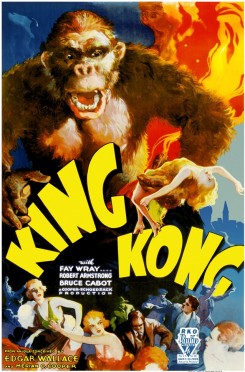
panel 5
- O’Brien biography continues.
- Merian Cooper was the head of RKO Pictures and co-producer of King Kong.
- Edgar Wallace was a prolific writer. Many movies were based on his work, including King Kong.
- “My masterpiece” is the film King Kong. This is confirmed in the next panel.
Page 6
panel 1
- “1933” is the year King Kong was released.
- Willis Junior, O’Brien’s son went blind from tuberculosis.
panels 2-5
- This continues the O’Brien biography.
- “Same year, the studio wanted a sequel: a ‘son of'” refers to Son of Kong which also came out in 1933. (Thanks commenter Paul Evans.) “It cheapened the original” could be a subtle swipe at ill-considered sequels to Moore’s DC work, including the inferior Before Watchmen.
Page 7
panel 1
- Again, this is O’Brien biography.
- The underground spider pit is a missing sequence cut from King Kong. According to Willis O’Brien: Special Effects Genius: (P18)
In the original film, [after falling from the log] the crew are devoured by spiders and other creatures in this “pit,” but this sequence was cut out and has never been found.
- “Eat you alive” has a double meaning: O’Brien’s guilt and the spiders eating Kong.
panels 2-5
- These panels form a fixed-camera sequence, which, as some films do fades to black.
panel 3
- “Japanese studio stole my idea” refers to how Willis had conceived a sequel, King Kong vs. Frankestein, which idea was stolen, reworked, and sold to Toho Studios, where it became King Kong vs. Godzilla. (Thanks to commenter Mike!)
- Again both “stole my idea” and “I was an artist in an industry…” echo Alan Moore’s struggles with DC Comics.
panels 3-4
- “It’s a beast. It knows nothing of love… and it always kills the beauty.” is a play on the famous final line of King Kong: “It was beauty killed the beast.”
- A biographical note: Moore and O’Neill (perhaps due to page constraints) omit much of O’Brien’s later life. He continued making movies, remarried, and lived until 1962.
Page 8
panel 1
- “Mighty King Joe” is a conflation of two O’Brien’s giant gorilla films: the 1933 King Kong and the 1949 Mighty Joe Young.
panel 2
- “Kia-Ora” is a British soft-drink.
panel 3
- “Icy Love” ahis appears to be based on an actual Walls brand ice cream, called “Heart”, which was available in the 1970s. It was apparently the most expensive such treat at the time.
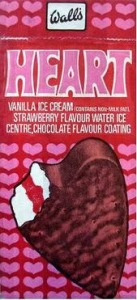 Neil Gaiman uses the same ice cream in Mr. Punch noting that, “Hearts were the most expensive ice-lollies that there were in the world. They were a shilling: a chocolate-covered ice-cream heart on a stick. White ice-cream with a blood-red steak across the middle”. Both Moore and Gaiman use the ice-cream “Heart” as a nostalgic memory of youth. (Thanks to FMB for noting the Gaiman connection.)
Neil Gaiman uses the same ice cream in Mr. Punch noting that, “Hearts were the most expensive ice-lollies that there were in the world. They were a shilling: a chocolate-covered ice-cream heart on a stick. White ice-cream with a blood-red steak across the middle”. Both Moore and Gaiman use the ice-cream “Heart” as a nostalgic memory of youth. (Thanks to FMB for noting the Gaiman connection.)
The name “Icy Love”, and next panel’s comment “there’s no flavour to it”, have obvious metaphorical force.
panels 4-5
- For notes on the Marilyn Monroe Screen Regrets cover (which appears before the stories in each issue) see notes for Cinema Purgatorio #1.
>Go to Purgatorio Annotations Index
>Go to Cinema Purgatorio #5 Moore and O’Neill annotations
Wow, all that stuff actually happened? It’s bizarre, I feel like I’ve become part of a comic! Feels like real life’s entered the comic instead of the other way round.
Nicely researched, Mr Joe. These stories just get weirder and weirder, eh? Looking forward to the next, and the one after that. Is there an ending intended for Purgatorio, or is it just gonna run til Alan runs out of ideas?
LikeLike
Also worth mentioning, of course, that Marilyn Monroe IS dead! In that photo she’s looking in her 50s, a good bit older than she actually survived to be. Does that mean in Purgatorio-death-land she’s in some way alive? Or not-dead, if that’s a difference. And it might be! Or doesn’t know she’s dead (aha!). Why doesn’t our protagonist, who seems to be “modern”, from the present, or some sort of present, realise that? How’s she reading a magazine about Marilyn wishing she was dead, when Marilyn is dead!!?!?
Or at least, ALMOST reading a magazine! She was disturbed before she started reading.
And that “Icy Love” with it’s blank, absent flavour. Oh, it’s too cruel! Alan, you magnificent bastard! I dunno how the sales are doing, but this is some sterling Alan Moore work. It’s a short piece in an indie anthology (although Garth Ennis has thrown his oar in too), but it’s top-quality stuff. Still, not like Alan writes rubbish anyway. Alan doesn’t even get lazy, or dash off half-arsed stuff quick for the money. Everything has the depth, the thought, and the deep research.
Compared to some of the garbage I’ve read in 2000AD, and other comics, over the decades, Alan is the definition of conscientious. As well as talented of course. Never lets the reader down, even when he’s been let down, and actively cheated and conspired against, by those in the “business”. As well as Hollywood’s “business”, which is even worse.
Anyway, nice to see Garth’s name on the cover too. Is Code Pru a thing made up just for Purga? Or is it all reprints from some other comic? What about the others?
I like Modded, it’s quite cute, and Fringe is interesting in that she doesn’t look like a typical comic-story young girl. She’s actually a bit unusual, not conventionally pretty. That’s nice to see. Of course she’s a sweet girl, if way too immature and more than a bit too young to be out there in the badlands, which seem to be most of the Earth.
The Vast really hasn’t grabbed me. So far 4 episodes, nothing’s bloody happened, and I don’t know and can’t tell who any of the characters are. I don’t think there are any. Whole thing has a sleepwalking, detached quality. I’m reading it but it’s like it’s not soaking in. Like it’s in some other language, or printed in a colour I can’t see.
Big Ant War Thingy is nice, though it started off historical and character-based drama. Now it’s gone odd sci-fi with giant ants (not even mentioned in the first episode). And it’s sort of gone off the trail a bit too, not really sure what should be happening, what’s at stake. Again, the main bloke’s character hasn’t developed at all since the first episode, where we had quite a bit. Is there a point to Civil Ant War?
But most importantly of all… why isn’t anyone else on here discussing this!?!? Providence gets loads of conversation, here I am talking to myself about all this! Someone opine! Don’t have to reply to me, or agree, or disagree. Just bloody say something!
Might be better, Joe, perhaps, to un-split the categories. Have one page for discussing each issue. Maybe keep the story notes separate, but keep all the chat for each issue in one place.
That said, you could join the articles together too. There’s around the same number of pages per issue as Providence (I think). So you could perhaps fit a whole issue’s notes on one.
Anyway… come talk to me, you bastards! How can Alan Moore be doing a new comic and nobody has any opinions about it!??
LikeLike
Oh BTW I’ve decided this comic is to be known as “Purga” for short. “CP” would be a bad idea. Just trust me, is why.
LikeLike
“Anyway… come talk to me, you bastards! How can Alan Moore be doing a new comic and nobody has any opinions about it!??”
Haha I’d like to discuss Moore comics earlier but I get these through the mail, and often up to a month after release, so I’m always late to the party (I just got this and Providence #10 today)!
This was very interesting, if not necessarily as “clever” as last issue’s Flame of Remorse Returns. (Although yeah that “Icy Love” ice cream bar being flavorless was pretty clever.)
First of all, great foliage by O’Neill, it looks amazing in black and white!
I would not have guessed that the dialogue was referring to a real person, I was assuming the character was a stand-in for the many early Hollywood creatives who were chewed up and spit out by the business. What a tragic story. (And it’s powerful how Kong has a “oh my god what have I done no no no!” look on his face on page 6 panel 3 where the dialogue talks of his wife murdering their children.)
I had the exact same thought about Moore vs Corporate Comics when I read the line “I love my craft, but…”
As for the “Purga” bigger picture, the manager and the usher are back again, and we actually see the Cinema Regrets magazine make an appearance in the story. No idea where it’s all going though (other than the obvious we’re-all-in-purgatory reveal – but knowing that Moore has specifically mentioned the TV show “Lost” as how NOT to end a story, I would guess there will be ultimately something deeper than just purgatory. Actually I take that back; even if it is just purgatory, there is already incredible depth in the serials themselves – like this issue’s tragic story of yet another swindled creative pioneer).
Thanks for the annotations!
And that Dinosaur and the Missing Link clip is fantastic.
LikeLike
Hi Archie! Sorry not to reply, only just noticed you had replied. This place doesn’t get much traffic for me to check often, and the “latest post” thing doesn’t seem to work properly.
As for the story… the last few Cinema Purgatorios have had themes. Married life, disillusionment, regret, lost time. Not paying attention to the reality of the situation around you. I might theorise some more on the page for #5. Ta for replying! Can’t believe how less popular than Providence this is. Perhaps there’s a lot more for us to guess about Providence, and the whole of HP’s work as a side reference.
LikeLike
I also am surprised at how little attention Cinema Purgatorio is receiving, but I suppose anthologies are not exactly all the rage these days.
I would guess that in a few years time, the collected Moore and O’Neill strips in here will be required reading in a lot of college film studies classes.
LikeLike
The figures sprawled at the feet of the tattered Kong model on the cover are representations of O’brien’s murdered sons and their murderer, his wife. One wears sunglasses and has a cane, implying blindness, while the female figure is holding a gun. The symbolism then of O’brien regrading this “on the edge” becomes easily self-evident…
LikeLike
Anthony – sorry I somehow missed your comment at the time – you’re right about the identities of the fallen figures on the cover… but I still don’t quite get “on the edge” – it seems like O’Brien had a shocker with his wife and kids murder/death – though he still had a long productive career after that.
LikeLike
Page 6 panel 2 refers to Son of Kong, 1933.
LikeLike
Thanks – added
LikeLike
The Japanese stealing his idea was King Kong vs Frankenstein being made into King Kong vs Godzilla behind his back.
LikeLiked by 1 person